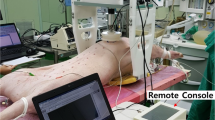Summary
The effect of transthoracic direct current countershock on the myocardium of 21 newborn piglets was studied. Myocardial damage was quantified by measuring the myocardial uptake of technetium-99m pyrophosphate injected 24 hours after countershock.
Substantial myocardial damage occurred in animals given greater than 150 joules/kg but not at lower energy doses. Damage occurred in both ventricular free walls, but more frequently in the right ventricle. The epicardial half of the myocardium was more severely affected than the endocardial half. The relationship between myocardial damage and total countershock energy dose was well modeled by an exponential function.
Transthoracic direct current countershock appears unlikely to cause myocardial damage in newborn piglets unless greatly elevated energy doses are employed.
Similar content being viewed by others
References
Adgey AAJ: Electrical energy requirements of ventricular defibrillation (Editorial).Br Heart J 40:1197–1199, 1978
Chameides L, Brown GE, Raye JR, Todres DI, Viles PH: Guidelines for defibrillation in infants and children. Report of the American Heart Association Target Activity Group: Cardiopulmonary Resuscitation in the Young.Circulation 55:502A-503A, 1977
Dahl CF, Ewy GA, Warner ED, Thomas ED: Myocardial necrosis from direct current countershock: Effect of paddle electrode size and time interval between discharges.Circulation 50:956–961, 1974
Davis JS, Lie JT, Bentinck DC, Titus JL, Tacker WA, Geddes LA: Cardiac damage due to electric current and energy. InCardiac Defibrillation Conference (Proceedings), Purdue University, West Lafayette, Indiana, October 1–3, 1975, pp 27–32
DiCola VC, Freedman GS, Downing SE, Zaret BL: Myocardial uptake of technetium-99m stannous pyrophosphate following direct current transthoracic countershock.Circulation 54:980–986, 1976
Doherty PW, McLaughlin PR, Billingham M, Hernoff R, Goris ML, Harrison DC: Cardiac damage produced by direct current countershock applied to the heart.Am J Cardiol 43:225–232, 1979
Ewy GA: Defibrillator paddle electrodes. InCardiac Defibrillation Conference (Proceedings), Purdue University, West Lafayette, Indiana, October 1–3, 1975, pp 33–44
Ewy GA, Tacker WA: Transchest electrical ventricular defibrillation.Am Heart J 91:403–404, 1976
Friedman WF: The intrinsic physiologic properties of the developing heart.Prog Cardiovasc Dis 25:87–111, 1972
Geddes LA, Tacker WA, Rosborough JF, Moore AG, Cabler PS: Electrical dose for ventricular defibrillation of large and small animals using precordial electrodes.J Clin Invest 53:310–319, 1974
Gutgesell HP, Tacker WA, Geddes LA, Davis JS, Lie JT, McNamara DG: Energy dose for ventricular defibrillation of children.Pediatrics 58:898–901, 1976
Hirakow R, Gotoh T: A quantitative ultrastructural study of the developing rat heart. InDevelopmental and Physiological Correlates of Cardiac Muscle (Lieberman M, Sano T eds). New York, Raven Press, 1975, pp 37–49
Jennrich R: Non-linear regression. InBiomedical Computer Programs P Series (Brown MB, ed). Berkeley, University of California Press, 1977, pp 464–483
Lee JC, Halloran KH, Taylor JFN, Downing SE: Coronary flow and myocardial metabolism in newborn lambs: Effects of hypoxia and acidemia.Am J Physiol 224:1381–1387, 1973
Legato MJ: Ultrastructural changes during normal growth in the dog and rat ventricular myofiber. InDevelopmental and Physiological Correlates of Cardiac Muscle (Lieberman M, Sano T, eds). New York, Raven Press, 1975, pp 249–274
Maruffo CA: Fine structural study of myocardial changes induced by isoproterenol in rhesus monkeys (Macac mulatta).Am J Pathol 50:27–37, 1967
Patton JN, Rantridge JF: Current required for ventricular defibrillation.Br Med J 1:513–514, 1979
Reichenbach DD, Benditt EP: Myofibrillar degeneration: A response of the myocardial cell to injury.Arch Pathol 85:189–199, 1968
Reichenbach DD, Benditt EP: Catecholamines and cardiomyopathy: The pathogenesis and potential importance of myofibrillar degeneration.Human Pathol 1:125–150, 1970
Resnekov L: Direct current shock. InCardiac Emergency Care (Chung EK, ed). Philadelphia, Lea and Feibiger, 1975, p 147
Rosenblum I, Wohl A, Stein A: Studies in cardiac necrosis I: Production of cardiac lesions with sympathomimetic amines.Toxicol Appl Pharmacol 7:1–17, 1965
Schneider RM, Hayslett JP, Downing SE, Berger HJ, Donabedian RK, Zaret BL: Effect of methylprednisolone upon technetium-99m pyrophosphate assessment of myocardial necrosis in the canine countershock model.Circulation 56:1029–1034, 1977
Su JY, Friedman WF: Comparison of the responses of fetal and adult cardiac muscle to hypoxia.Am J Physiol 224:1249–1253, 1973
Tacker WA, Davis JS, Lie JT, Titus JL, Geddes LA: Cardiac damage produced by transchest damped sine wave shocks.Med Instrum 12:27–30, 1978
Tedeschi CG, White CW: A morphologic study of canine hearts subjected to fibrillation, electrical defibrillation and manual compression.Circulation 9:916–921, 1954
Van Vleet JF, Rebar AH, Ferrans VJ: Acute cobalt and isoproterenol cardiotoxicity in swine: Protection by selenium-vitamin E supplementation and potentiation by stress susceptible phenotype.Am J Vet Res 38:991–1002, 1977
Van Vleet JF, Tacker WA, Geddes LA, Ferrans VJ: Acute cardiac damage in dogs given multiple transthoracic shocks with a trapezoidal wave-form defibrillator.Am J Vet Res 38:617–626, 1977
Wildenthal K: Metabolic maturation in the fetal mouse heart. InFetal and Newborn Cardiovascular Physiology. Vol. 1 (Longo LD, Reneau DD. eds). New York, Carland STPM Press, 1978. pp 257–270
Author information
Authors and Affiliations
Additional information
Developed at the Health Sciences Computing Facility, UCLA. Sponsored by NIH special research resources grant RR-3.
Rights and permissions
About this article
Cite this article
Gaba, D.M., Talner, N.S. Myocardial damage following transthoracic direct current countershock in newborn piglets. Pediatr Cardiol 2, 281–288 (1982). https://doi.org/10.1007/BF02426974
Revised:
Issue Date:
DOI: https://doi.org/10.1007/BF02426974




